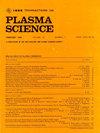On Kink Modes and Low-n Kink β Limits in HL-2A Sawtooth Discharges
IF 1.5
4区 物理与天体物理
Q3 PHYSICS, FLUIDS & PLASMAS
引用次数: 0
Abstract
Kink mode is one of the most important macroinstabilities in sawtooth discharge. In this article, the nature of kink modes was investigated through a combination of HL-2A experiments and simulations. MultipleHL-2A锯齿状放电的扭结模式和低n扭结β极限
扭结模式是锯齿放电中最重要的宏观不稳定性之一。本文通过HL-2A实验和模拟相结合的方法研究了扭结模式的性质。HL-2A锯齿状放电中存在多个n(环面模数)扭结分支。确定了不同的n-扭结模式在等离子体不稳定性中的不同作用。将n = 1模态确定为优势扭结模态。随着n值的增大,模态结构向中心收缩。模线性增长率与模是否主导等离子体无关。短波长的减弱效应及其较高的内部局域性部分抵消了高n模式在等离子体全局不稳定性中的优势。在实践中,如果n = 1模态是稳定的,那么多个n扭结分支往往是稳定的。在低n模式中,在$\mathbf {q}_{\mathbf {0}}=\mathbf{1.05}$及其邻近区域,n $\gt$ 1模式的稳定极限不低于n = 1模式,在考虑正常抛物线电流密度分布时,n = 1和2模式的稳定极限随$\mathbf {q}_{\mathbf{0}}$而减小,并表现出一定的线性关系,这为HL-2A锯齿状放电的操作值$\boldsymbol {\beta}$的确定提供了提示。
本文章由计算机程序翻译,如有差异,请以英文原文为准。
求助全文
约1分钟内获得全文
求助全文
来源期刊

IEEE Transactions on Plasma Science
物理-物理:流体与等离子体
CiteScore
3.00
自引率
20.00%
发文量
538
审稿时长
3.8 months
期刊介绍:
The scope covers all aspects of the theory and application of plasma science. It includes the following areas: magnetohydrodynamics; thermionics and plasma diodes; basic plasma phenomena; gaseous electronics; microwave/plasma interaction; electron, ion, and plasma sources; space plasmas; intense electron and ion beams; laser-plasma interactions; plasma diagnostics; plasma chemistry and processing; solid-state plasmas; plasma heating; plasma for controlled fusion research; high energy density plasmas; industrial/commercial applications of plasma physics; plasma waves and instabilities; and high power microwave and submillimeter wave generation.
 求助内容:
求助内容: 应助结果提醒方式:
应助结果提醒方式:


